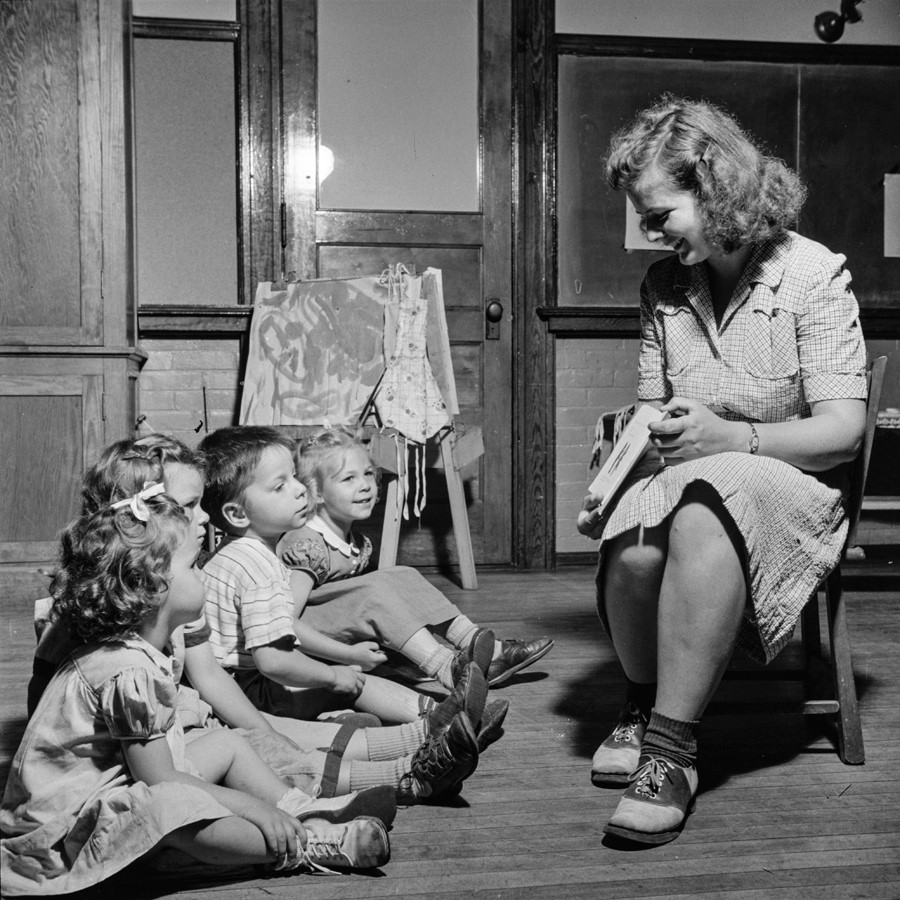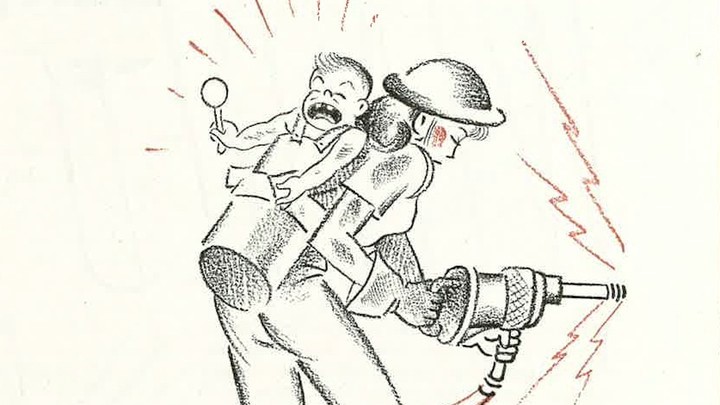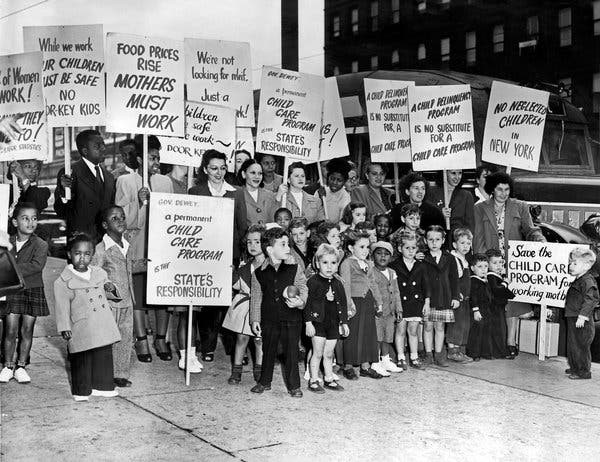We face many big challenges. And we will need strong, bold policies to meaningfully address them. Solving our child-care crisis is one of those challenges, and a study of World War II government efforts to ensure accessible and affordable high-quality child care points the way to the kind of bold action we need.
The child care crisis
A number of studies have established that high-quality early childhood programs provide significant community and individual benefits. One found that “per dollar invested, early childhood programs increase present value of state per capita earnings by $5 to $9.” Universal preschool programs have also been shown to offer significant benefits to all children, even producing better outcomes for the most disadvantaged children than means-tested programs. Yet, even before the pandemic, most families struggled with a lack of desirable child-care options.
The pandemic has now created a child-care crisis. As Lisa Dodson and Mary King point out: “By some estimates, as many as 4.5 million child-care ‘slots’ may be permanently lost and as many as 40 percent of child-care providers say they will never reopen.” The lack of child care is greatly hindering our recovery from the pandemic. Women suffered far greater job losses than men during 2020, including as child-care workers, and the child-care crisis has made it difficult for many working mothers to return to the labor force. The cost goes beyond the immediate family hardship from lost income; there is strong evidence that a sustained period without work, the so-called employment gap, will result in significantly lower lifetime earnings and reduced retirement benefits.
To his credit, President Biden has recognized the importance of strengthening our care economy. His proposed American Families Plan includes some $225 billion in tax credits to help make child care more affordable for working families. According to a White House fact sheet, families would “receive a tax credit for as much as half of their spending on qualified child care for children under age 13, up to a total of $4,000 for one child or $8,000 for two or more children. . . . The credit can be used for expenses ranging from full-time care to after school care to summer care.”
But tax credits don’t ensure the existence of convenient, affordable, high-quality child-care facilities staffed by well-paid and trained child-care providers. And if that is what we really want, we will need to directly provide it. That is what the government did during World War II. While its program was far from perfect, in part because it was designed to be short-term, it provides an example of the type of strong, bold action we will need to overcome our current child-care crisis.
Federal support for child care
During World War II the United States government financed a heavily-subsidized child-care program. From August 1943 through February 1946, the Federal Works Agency (FWA), using Lanham Act funds, provided some $52 million in grants for child-care services (equal to more than $1 billion today) to any approved community group that could demonstrate a war-related need for the service. At its July 1944 peak, 3,102 federally subsidized child-care centers, with some 130,000 children enrolled, operated throughout the country. There was at least one center in every state but New Mexico, which decided against participation in the program. By the end of the war, between 550,000 and 600,000 children received some care from Lanham Act funded child-care programs.
Communities were allowed to use the federal grant money to cover most of the costs involved in establishing and running their centers, including facilities construction and upkeep, staff wages and most other daily operating costs. They were required to provide some matching funds, most of which came from fees paid by the parents of children enrolled in the program. However, these fees were capped. In the fall of 1943, the FWA established a ceiling on fees of 50 cents per child per day (about $7 now), which was raised to 75 cents in July 1945. And those fees included snacks, lunch, and in some cases dinner as well. Overall, the federal subsidy covered two-thirds of the total maintenance and operation of the centers.
The only eligibility requirement for enrollment was a mother’s employment status: she had to be working at a job considered important to the war effort, and this was not limited to military production. Center hours varied, but many accommodated the round-the-clock manufacturing schedule, staying open 24 hours a day, 6 days a week.
The centers served preschoolers (infants, toddlers, and children up to 5 years of age) and school-age children (6 to 14 years of age). In July 1944, approximately 53,000 preschoolers and 77,000 school-age children were enrolled. School-age enrollment always climbed during summer vacation. However, in most months, preschoolers made up the majority of the children served by Lanham Act-funded centers. Enrollment of preschoolers peaked at some 74,000 in May 1945.
Some 90 percent of the centers were housed in public schools, with newly contructed housing projects providing the next most used location. Although local school boards were free to decide program standards–including staff-child ratios, worker qualifications, and facility design–state boards of education were responsible for program supervision. The recommended teacher-child ratio was 10-to-1, and most centers complied. According to Chris M. Herbst,
Anecdotal evidence suggests that preschool-aged children engaged in indoor and outdoor play; used educational materials such paints, clay, and musical instruments; and took regular naps. . . . Programs for school-aged children included . . . outdoor activities, participation in music and drama clubs, library reading, and assistance with schoolwork.

Gordon Parks / Library of Congress / The Crowley Company // Reports from the Economic Front
While quality did vary–largely the result of differences in community support for public child care, the willingness of cities to provide additional financial support, and the ability of centers to hire trained professionals to develop and oversee program activities–the centers did their best to deliver a high-quality childhood education. As Ruth Peason Koshuk, the author of a 1947 study of the developmental records of 500 children, 2 to 5 years of age, at two Los Angeles Country centers, describes:
In these two . . . schools, as elsewhere, the program has developed since 1943, toward recognized standards of early childhood education. The aim has been to apply the best of existing standards, and to maintain as close contact with the home as possible. In-service training courses carrying college credit have been given, for the teaching staff, and a mutually helpful parent education program carried on in spite of difficulties inherent in a child care situation.
There has been a corresponding development in the basic records. A pre-entrance medical examination has been required by state law since the first center opened. In December 1943 a developmental record was added, which is filled out by the director during an unhurried interview with the mother just before a child enters. One page is devoted to infancy experience; the four following cover briefly the child’s development history, with emphasis on emotional experience, behavior problems he has presented to the parents, if any, and the control methods used, as well as the personal-social behavior traits which they value and desire for the child. After entrance, observational notes and semester reports are compiled by the teachers. Intelligence testing has been limited to cases where it seemed especially indicated. A closing record is filled out, in most cases, by the parent when a child is withdrawn. These records are considered a minimum. They have proved indispensable as aids to the teachers in guiding the individual children and as a basis for conferences on behavior in the home.
A 2013 study of the long-term effects on mothers and children from use of Lanham centers found a substantial increase in maternal employment, even five years after the end of the program, and “strong and persistent positive effects on well-being” for their children.
In short, despite many shortcomings, these Lanham centers, as Thalia Ertman sums up,
broke ground as the first and, to date, only time in American history when parents could send their children to federally-subsidized child care, regardless of income, and do so affordably. . . .
Additionally, these centers are seen as historically important because they sought to address the needs of both children and mothers. Rather than simply functioning as holding pens for children while their mothers were at work, the Lanham child care centers were found to have a strong and persistent positive effect on the well-being of children.
The federal government also supported some private employer-sponsored child care during the war. The most well-known example is the two massive centers built by the Kaiser Company in Portland, Oregon to provide child care for the children of workers at their Portland Yards and Oregon Shipbuilding Corporation. The centers were located right at the front of the shipyards, making it easy for mothers to drop their children off and pick them up, and were operated on a 24-hour schedule. They were also large, each caring for up to 1,125 children between 18 months and 6 years of age. The centers had their own medical clinic, cafeteria, and large play areas, and employed highly trained staff. Parents paid $5 for a six-day week for one child and $3.75 for each additional child. For a small additional fee, the centers also prepared a small dinner for parents to pick up at the end of their working day.
While the Kaiser Company received much national praise as well as appreciation from its employees with young children, these centers were largely paid for by the government. Government funds directly paid for their construction, and a majority of the costs of running the center, including staff salaries, were included in the company’s cost-plus contracting with the military.
Political dynamics
There was considerable opposition to federal financing of group child care, especially for children younger than 6 years of age. The sentiment is captured in this quote from a 1943 New York Times article: “The worst mother is better than the best institution when it is a matter of child care, Mayor La Guardia declared.” Even the War Manpower Commission initially opposed mothers with young children working outside the home, even in service of the war effort, stating that “The first responsibility of women with young children, in war as in peace, is to give suitable care in their own homes to their children.”
But on-the-ground realities made this an untenable position for both the government and business. Women sought jobs, whether out of economic necessity or patriotism. The government, highlighted by its Rosie the Riveter campaign, was eager to encourage their employment in industries producing for the war effort. And, despite public sentiment, a significant number of those women were mothers with young children.
The growing importance of women in the workplace, and especially mothers with young children, is captured in employment trends in Portland, Oregon. Women began moving into the defense workforce in great numbers starting in 1942, with the number employed in local war industries climbing from 7,000 in November 1942 to 40,000 in June 1943. An official with the state child-care committee reported that “a check of six shipyards reveals that the number of women employed in the shipyards has increased 25 percent in one month and that the number is going to increase more rapidly in the future.”
The number of employed mothers was also rapidly growing. According to the Council of Social Agencies, “Despite the recommendations of the War Manpower Commission . . . thousands of young mothers in their twenties and thirties have accepted jobs in war industries and other businesses in Multnomah County. Of the 8,000 women employed at the Oregon Shipyards in January, 1943, 32 percent of them had children, 16 percent having pre-school children.”
Portland was far from unique. During the war, for the first time, married women workers outnumbered single women workers. Increasingly, employers began to recognize the need for child care to address absenteeism problems. As a “women’s counselor” at the Bendix Aviation Corporation in New Jersey explained to reporters in 1943, child care is one of the biggest concerns for new hires. “We feel a mother should be with her small baby if possible. But many of them have to come back. Their husbands are in the service and they can’t get along on his allotment.” Media stories, many unsubstantiated, of children left in parked cars outside workplaces or fending for themselves at home, also contributed to a greater public acceptance of group child care.

Finally, the government took action. The Federal Works Agency was one of two new super agencies established in 1939 to oversee the large number of agencies created during the New Deal period. In 1940 President Roosevelt signed into law the Lanham Act, which authorized the FWA to fund and supervise the construction of needed public infrastructure, such as housing, hospitals, water and sewer systems, police and firefighting facilities, and recreation centers, in communities experiencing rapid growth because of the defense buildup. In August 1942, the FWA decided, without any public debate, that public infrastructure also meant child care, and it began its program of support for the construction and operation of group child-care facilities.
The Federal Works Agency, the other super agency, whose oversight responsibilities included the Children’s Bureau and the U.S. Office of Education, opposed the FWA’s new child-care initiative. It did so not only because it believed that child care fell under its mandate, but also because the leadership of the Children’s Bureau and Office of Education opposed group child care. The FWA won the political battle, and in July 1943, Congress authorized additional funding for the FWA’s child-care efforts.
And, as William M. Tuttle, Jr. describes, public pressure played an important part in the victory:
the proponents of group child care organized a potent lobbying effort. The women’s auxiliaries of certain industrial unions, such as the United Electrical Workers and the United Auto Workers, joined with community leaders and FWA officials in the effort. Also influential were the six women members of the House of Representatives. In February 1944, Representative Mary T. Norton presented to the House “a joint appeal” for immediate funds to expand the wartime child day care program under the FWA.
Termination and a step back
Congressional support for group child care was always tied to wartime needs, a position shared by most FWA officials. The May 1945 Allied victory in Europe brought a drop in war production, and a reduction in FWA community child care approvals and renewals. In August, after the Japanese surrender brought the war to a close, the FWA announced that it would end its funding of child-care centers as soon as possible, but no later than the end of October 1945.
Almost immediately thousands of individuals wrote letters, sent wires, and signed petitions calling for the continuation of the program. Officials in California, the location of many war-related manufacturing sites and nearly 25 percent of all children enrolled in Lanham Act centers in August 1945, also weighed in, strongly supporting the call. Congress yielded, largely influenced by the argument that since it would be months before all the “men” in the military returned to the country, mothers had no choice but to continue working and needed the support of the centers to do so. It approved new funds, but only enough to keep the centers operating until the end of February 1946.
The great majority of centers rapidly closed not long after the termination of federal support, with demonstrations following many of the closings. The common assumption was that women would not mind the closures, since most would be happy to return to homemaking. Many women were, in fact, forced out of the labor force, disproportionately suffering from post-war industrial layoffs. But by 1947, women’s labor force participation was again on the rise and a new push began for a renewal of federal support for community child-care centers. Unfortunately, the government refused to change its position. During the Korean War, Congress did approve a public child-care bill, but then it refused to authorize any funding.

Credit: The New York Times // Reports from the Economic Front
Finally, in 1954, as Sonya Michel explains, “Congress found an approach to child care it could live with: the child-care tax deduction.” While the child-care tax deduction did offer some financial relief to some families, it did nothing to ensure the availability of affordable, high-quality child care. The history of child care during World War II makes clear that this turn to market-based tax policy to solve child-care problems represented a big step back for working women and their children. And this was well understood by most working people at the time.
Sadly, this history has been forgotten, and Biden’s commitment to expand the child-care tax credit is now seen as an important step forward. History shows we can and need to do better.
[Martin Hart-Landsberg is Professor Emeritus of Economics at Lewis and Clark College, Portland, Oregon. He is the author of seven books on issues related to globalization and the political economy of East Asia. His work has been translated into Hindi, Japanese, Korean, Mandarin, Spanish, Turkish, and Norwegian. He has also published numerous articles in journals such as Monthly Review, Review of Radical Political Economics, Critical Asian Studies, Historical Materialism, Against the Current, and the Journal of Contemporary Asia.
He is a member of the Board of Directors of the Korea Policy Institute and the steering committee of the Alliance of Scholars Concerned About Korea, and has served as consultant for the Korea program of the American Friends Service Committee. He is the chair of Portland Rising, a committee of Portland Jobs With Justice, and a member of the organizing committee of the Workers’ Rights Board (Portland, Oregon).]


Spread the word